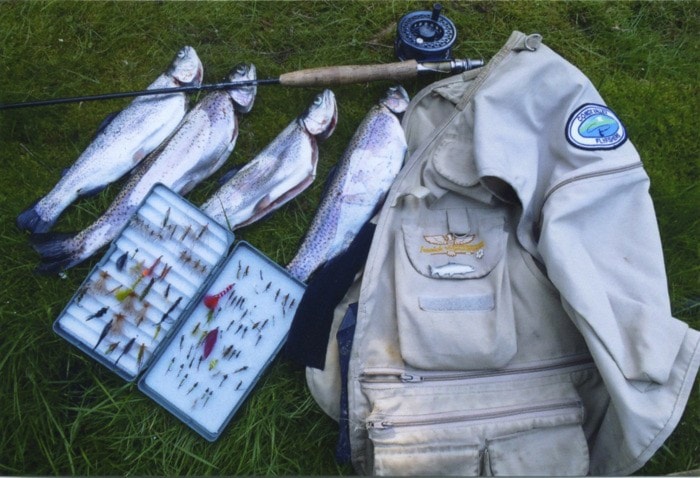The picture with this column is of a catch of trout I was fortunate enough to make on Good Friday. I do not normally fish on major holiday weekends for the simple reason that I try to avoid crowded fishing situations. However on this day an exception was made and I went down to my favourite fishing hole early in the morning and was able to avoid congestion at the boat launch.
The situation was a little like where Jesus said to Peter and the other fishers at the Sea of Galilee, “Cast your nets on the other side and you will catch fish.” I was casting my fly on the other side of the lake and was catching fish. It helped quite a bit that one of my fly patterns was an old, tried and successful one developed by the late Jack Shaw, and my line was suitable for the situation.
The trout in the picture are what we call “one-meal fish” and in this case they exceeded what Elaine and I would eat for a normal meal. In case you wonder what we do with extra fish – they are shared with others of our generation who no longer fish for a variety of reasons – age being one of them.
When fishing in the early stages of the season you should be guided by the types of insects in the waters you fish and their stage of development. After I keep my first fish I gill and gut it to see what it is eating.
The condition of the lake is also important because at the beginning of the season many freshwater lakes go through a stage of what is known as “turning over.” This means that the waters at the lower depths of the lake come to the surface, accompanied by algae blooms and murky waters, thereby creating conditions of low visibility in the water.
The lake where I was fishing was in a growing state of turning over and for the first time in my many decades on the lakes I watched the waters churn as the lake turned over. It was fascinating. Fishing goes off for few days during turnover – the waters in the part of the lake where I fished were still clear.
Suitable fly patterns for this season are large nymphs and leeches. On this day I began my fishing with a pale green Dean Hodgson sedge pupae and a Jack Shaw blood leech. There are many other leech and sedge pupae patterns that would have produced fish. Chironomid insect patterns can also be important during this period of the year, but I usually wait until I see them emerging before I use them.
Any person capable of rowing or paddling a boat is able to successfully angle with leech and nymph patterns. Use a simple sinking fly line or a lightly weighted spinning outfit and slowly troll along the edges of the deeper water.
On this occasion I used a high-end RST fly fishing set-up with a medium slow sinking line on one rod with the leech pattern and on my second rod I used the sedge pattern. Both combinations worked, but I had more action on the leech as the day progressed.
For anglers new to fly fishing or if you have children in the boat, a good technique is to slowly row, occasionally stop rowing and retrieve the leech in a fairly rapid motion with pauses as you strip the fly towards you. In effect you are letting the boat do the casting as you learn the skill of retrieving a fly in a lifelike movement with the occasional brief pause or complete stop.
All you do is strip the line slowly toward you and let it coil on the bottom of the boat. When you get it near the boat simply let it sink and row away from it and repeat the process. Be warned that a one-meal trout can hit your fly hard enough to break it off.
When I was doing this technique a couple of days ago I was broken off twice by two powerful strikes. My mentor Jack Shaw’s ghostly voice came out from the past and said, “Your hand is too heavy, Ralph.” Hard strikes make good fish tales.
Ralph Shaw is a master fly fisherman who was awarded the Order of Canada in 1984 for his conservation efforts. In 20 years of writing a column in the Comox Valley Record it has won several awards.
